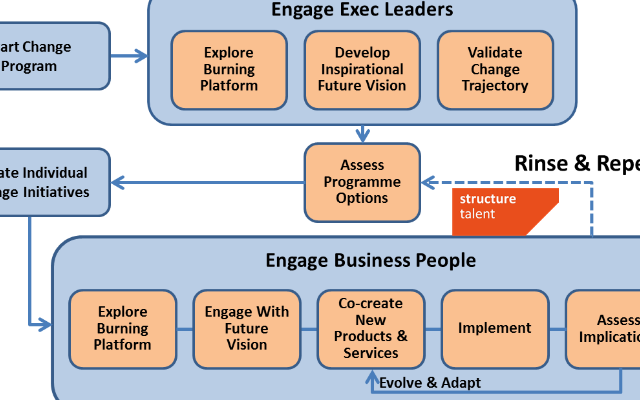You may remember Scott’s Dilemma. Within that post we outlined a somewhat realistic description of an aspiring change agent who wanted to transform his 100 year old defense contractor. A few of the couple of hundred viewers offered comments -your thoughtful suggestions were most welcome. Apart from hinting that Scott should head for the hills, the primary advice was to find like-minded managers within the organisation to highlight any dissonance between business challenges and espoused mission, vision, and strategy.
But people like Scott have real challenges. In large established organizations, there are often plenty of power politics going on. Most of those folks in power got there by diligently climbing the anthill. They’re not about to give up their privileged positions so easily. People like Scott need to first understand them and their motivations, side step where possible, and grapple with the few battles that are winnable. Plenty of incumbent managers will happily jump in and claim victory based on his hard work. But they probably don’t have the same vision of the future. All that they want is to make sure that whatever change does occur, it actually supports and enhances their position and status. All of that has to be dealt with before transformational change can take hold and become the business as usual dynamic of “rinse and repeat.”
Here we have attempted to outline some potential forms of support that we felt the SSI team needed and how we could help Scott achieve his aims. A more concise description of the advice appears in the image above (minus any of the political nuance).
Validating SSI’s Transformation Agenda
What we know is that SSI had bought a product company and added it into the mixed/traditional system integration business model; a business model that remains firmly anchored around defense contracting, large scale integration and fixed contracts. Our sense was that:
- Leaders at SSI may see the technology product vendor acquisition is some sort of a “bolt-on”.
Their perception is that the existing business must carry on and that, over time, the product approach will gradually influence the shape of the current business model. Furthermore, the exec leadership team may not all see the fundamental changes in behavior required to turn the organisational culture to support a more product-oriented business. The importance of helping them see and articulate that difference cannot be understated. Either way, the rest of the organisation will not so much react to what is said or stated. Instead, people will carefully observe the attitudes and behaviors of the exec leaders-especially where and how leaders spend their time. So the exec leadership team members need to ask themselves, what’s the ritual change in behavior in their own behavior that will signal to the rest of the organisation that they are serious about wanting this new outcome? - There may be a lack of a shared understanding or agreement around the newly espoused product-oriented strategy.
From the point of view of individual leadership team members, there may be nothing to worry about in the short term. Some are probably quite happy with the status quo. The reality is that most problems and transformation roadblocks emanate from the senior leadership team. They might all nod at the right times (to do otherwise is career limiting), but validating whether they truly have a shared understanding of the challenges and real agreement on the best approach usually requires face-to-face facilitation of them as a group. We can help you facilitate this sort of conversation, but it needs careful pre-planning and engagement. - Some may have competing agendas.
It’s not uncommon to find that different leaders want to claim victory and set up ostensibly competitive initiatives in support of the strategy. Regardless of whether that is happening, people working at the next couple of levels below the senior leadership team are already carefully reviewing their personal/parochial strategy, working out how to position themselves and their organisations. The further down the hierarchy you go, the less alignment there is around the articulated strategy. Assuming that we have already engaged the senior leadership team, the trick is then to connect lower down, bringing them together and then challenging them to invent the future together. They need to think it was their idea anyway. - You still need to identify and highlight the burning platform.
You need tolight the fire within, such that everyone in the organisation can see how the current approach is unsustainable. To mix a metaphor or two, the problem is that while executives can happily discuss the arrangement of deck chairs, while the boat slowly slides below the waves of mediocrity and irrelevance. Nimble and agile competitors are coming to eat your lunch and steal the future. That’s true of every business. Some come with disruptive business models that engage customers directly, leveraging modern digital cloud infrastructure, 3D printing and/or IoT to totally transform the way value is delivered. The trick is to highlight these dangers such that everyone engages in the journey of reinvention. - Then articulate a compelling future vision and re-assess the change trajectory. Having explored why the current status quo is unsustainable, it’s then a question of engaging the leadership team into painting a compelling picture of the future. What’s the mountain the organisation has to climb? What does it look like and will it inspire people in the business to travel there. Here’s the truth: on complex change programmes, things seldom go as planned. A never-ending stream of challenges and roadblocks come along and threaten to derail and delay progress. Even the most committed and healthiest of teams will stray from the path without clear objectives that are rooted in the organisational purpose. The question is, despite these uncertainties and roadblocks, how can teams stay true to the commander’s intent?
So Many Things To Understand
At this stage, forming a clear idea as to the potential scope, perceived problems, and areas of contention becomes … er, challenging.
- What is the scope you have in mind?
You used the phrase “top-to-bottom” yet these sorts of change agendas are not something that can be imposed on the organisation. While the leadership team can set the trajectory and direction, the change programme is certainly not something that can be outsourced-the organisation and the people within it need to “do it” to themselves. We can help you plan and shape that, and facilitate some of the early sessions. However, the business itself has to engage into this process and make it their own. Indeed, success will only occur when the people themselves take on the methods and adapt them to your own unique culture-SSI has to grow its own change muscles and attendant reflexes (management practices). - What is your remit?
Do you see your challenge as primarily/initially a question of engaging the rest of the exec/senior leadership team? Or is it a question of “going around” those sorts of people and directly engaging the engineering people themselves into seeing the world differently? I am sure it is a bit of both. As we’ve already hinted, there is a lot of thinking, planning and positioning required for this sort of change effort to succeed. We can help you prepare for that, but there will inevitably come a point where the organisational PMO needs to take over. The real challenge is to shape the change effort such that it doesn’t become bogged down in project plans and a tick box mentality. - I am sure that you have thought about budgets?
How will you scale the programme? There are a set of co-creation methods and techniques that will enable the organisation to engage on this sort of change journey without spending a fortune on an army of external consultants. Subtly different, once you get going, people are often amazed at just how quickly that change agenda can build and the energy it creates. But that needs commitment; especially from the leadership team. So we would normally need to start by engaging the hearts and minds of the senior leadership team. That could be done through a mixture of intake interviews and facilitated workshops.
So before you can get to the stage where the organisation is well established on a transformational trajectory-where change has become “business as usual”, with multiple teams happily working through “rinse and repeat” cycles-you really need to engage the exec leadership team and validate their commitment to the journey ahead.
In conclusion, I would point to Bill Taylor’s HBR article which in turn quotes a 25 year old paper:
“… executives and entrepreneurs face two very different sorts of risks. One is that their organization will make a bold move that fails-a risk they call “sinking the boat.” The other is that their organization will fail to make a bold move that would have succeeded-a risk they call “missing the boat.” Naturally, most executives worry more about sinking the boat than missing the boat, which is why so many organizations, even in flush times, are so cautious and conservative. To me, though, the opportunity for executives and entrepreneurs is to recognize the power of rocking the boat-searching for big ideas and small wrinkles, inside and outside the organization, that help you make waves and change course.”
For SSI, some will see the product and service strategy as having the potential to sink the boat. Others don’t want to miss the boat, while many managers are happy to avoid rocking the boat as they head for retirement. The reality is that SSI doesn’t need or want to stay on a boat – it needs a helicopter, or a spaceship, with an army of drones.
Read more by Derek Miers, here
Article by channel:
Everything you need to know about Digital Transformation
The best articles, news and events direct to your inbox
Read more articles tagged: Change & Transformation, Culture, Featured






